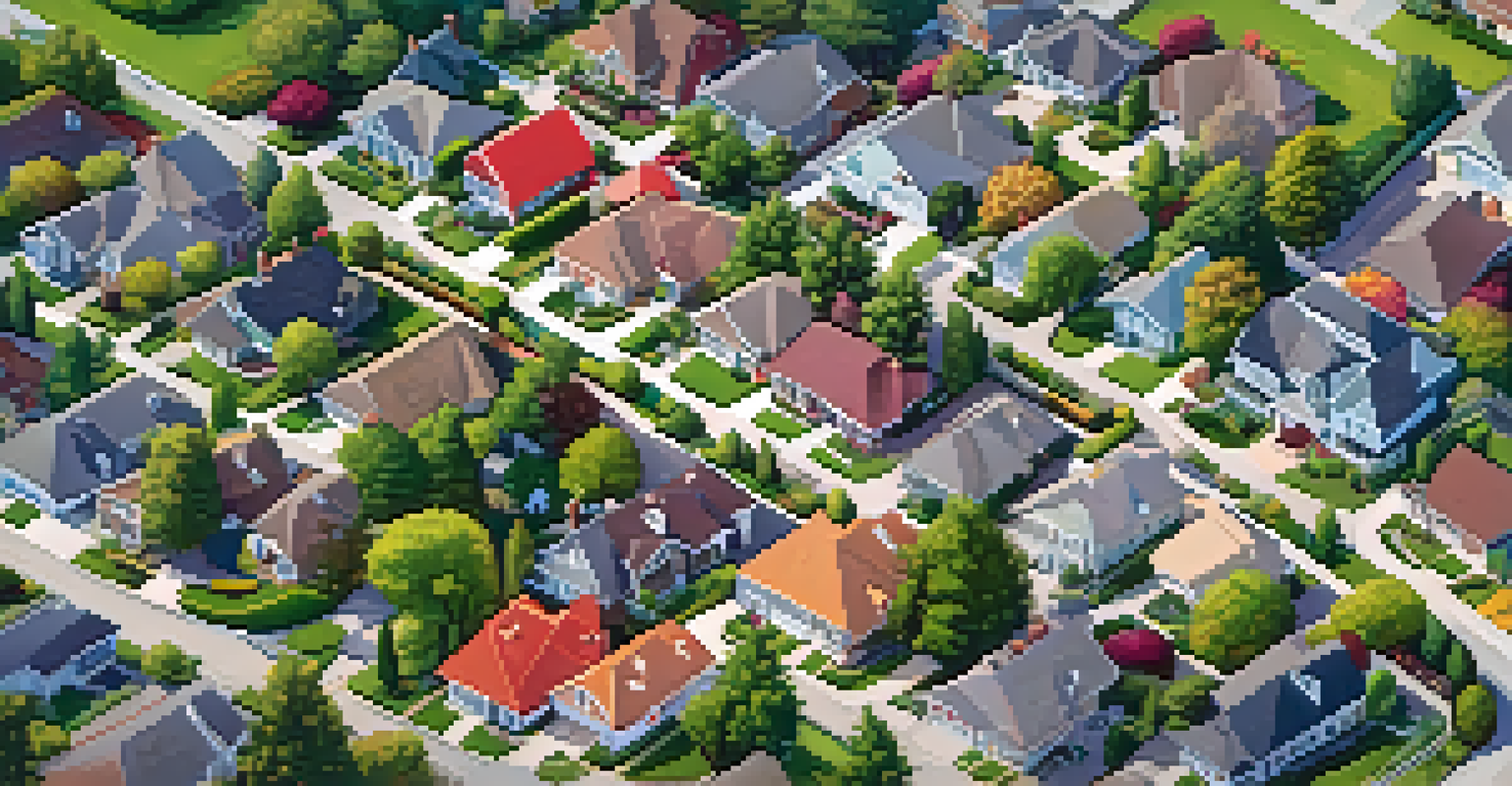The Evolution of Real Estate Marketing through Virtual Tours

Understanding the Basics of Real Estate Marketing
Real estate marketing has always been about showcasing properties in the best possible light. Traditionally, this meant relying on photographs, brochures, and open houses to attract potential buyers. However, these methods often fell short, as they could only provide a limited view of a property. This is where the evolution into more dynamic marketing techniques began to take shape, paving the way for innovative solutions like virtual tours.
The future of real estate is not about selling houses but about selling lifestyles, experiences, and dreams.
As technology advanced, so did the strategies used to market real estate. Agents realized that buyers were looking for more immersive experiences that could convey the true feel of a home. This understanding led to the exploration of digital tools that could bridge the gap between physical and virtual experiences. Thus, virtual tours emerged as a game-changing addition to the marketing toolkit.
With the rise of the internet and mobile technology, the demand for engaging content grew. Buyers wanted to explore homes at their own pace and convenience, without the pressure of in-person visits. This shift in consumer behavior prompted real estate marketers to embrace virtual tours, transforming the landscape of property marketing.
The Birth of Virtual Tours: A Game Changer
Virtual tours began to gain traction in the early 2000s with the advancement of 3D imaging technology. Initially, they were complex and costly, limiting their use to high-end properties. However, as technology progressed, the production of virtual tours became more accessible and affordable for regular listings. This marked a significant turning point in real estate marketing, as agents could now showcase properties in a more interactive way.

The ability to walk through a home virtually, using 360-degree views, offered potential buyers a unique perspective. They could explore rooms, view layouts, and get a sense of the space without stepping foot inside. This not only enhanced the buyer's experience but also saved time for both buyers and agents by filtering out properties that didn't meet expectations.
Virtual Tours Revolutionize Marketing
The introduction of virtual tours has transformed real estate marketing by providing immersive experiences that engage buyers more effectively.
Virtual tours quickly became a preferred method for showcasing properties, especially in a competitive market. As more buyers recognized the value of this technology, agents who adopted virtual tours saw a noticeable increase in engagement and interest in their listings. The shift towards virtual experiences was undeniable, setting the stage for further innovation.
Technological Advancements Fueling Virtual Tours
The evolution of virtual tours can largely be attributed to advancements in technology. High-quality cameras, drones, and user-friendly software have made it easier than ever to create stunning virtual experiences. These tools allow real estate agents to capture properties in immersive detail, showcasing everything from spacious living rooms to cozy nooks.
In the world of real estate, the key to success is not just in showing properties but in making buyers feel at home before they even step inside.
Moreover, the integration of virtual reality (VR) has taken virtual tours to a whole new level. With VR headsets, potential buyers can experience properties as if they were physically present, adding an extra layer of immersion. This technology has sparked interest from tech-savvy buyers who crave innovative ways to explore homes.
As the tech landscape continues to evolve, so too does the potential of virtual tours. Innovations such as augmented reality (AR) are starting to make their way into real estate marketing, allowing buyers to visualize changes in a space or see how furniture would fit in a room. These advancements promise to enhance the buying experience even further.
The Impact of COVID-19 on Real Estate Marketing
The COVID-19 pandemic drastically altered the way real estate was marketed and sold, pushing virtual tours into the spotlight. With social distancing measures in place, traditional open houses were no longer viable, leaving agents scrambling for alternatives. Virtual tours emerged as a safe and effective way to showcase properties while keeping everyone safe.
During this time, many buyers turned to online platforms to search for homes, and virtual tours became essential in the decision-making process. The ability to explore properties from the comfort of their own homes made buyers feel more secure and informed, enabling them to narrow down their choices before scheduling in-person visits.
Tech Advances Enhance Buyer Experience
Technological innovations such as VR and AR are continuously improving virtual tours, allowing potential buyers to interact with properties in more dynamic ways.
This shift not only helped maintain sales during uncertain times but also highlighted the importance of incorporating technology into real estate marketing strategies. Agents who had already embraced virtual tours were better positioned to adapt to the changing landscape, proving that innovation in marketing can lead to sustained success.
Consumer Preferences Shifting Towards Virtual Experiences
As the real estate market adapts to the digital age, consumer preferences have shifted significantly. Many buyers now expect virtual tours as a standard part of the home-buying process. These immersive experiences allow them to visualize themselves in a space, helping to create an emotional connection before making a commitment.
Surveys indicate that a significant percentage of homebuyers prefer listings that include virtual tours over those that do not. This trend has led to an increase in demand for properties that utilize this technology, pushing agents to invest in high-quality virtual tour production. The ability to stand out in a crowded market has never been more critical.
Additionally, the convenience of virtual tours appeals to a wide range of buyers, from first-time homeowners to seasoned investors. As more people embrace technology in their everyday lives, the expectation for innovative marketing methods in real estate continues to grow.
Integrating Virtual Tours with Other Marketing Strategies
Virtual tours are not just standalone tools; they can be integrated with other marketing strategies to amplify their impact. By combining virtual tours with social media campaigns, email marketing, and traditional listings, agents can create a cohesive and engaging marketing strategy. This multi-channel approach can help reach a wider audience and generate more leads.
For instance, sharing virtual tours on social media platforms can lead to increased visibility and engagement. Potential buyers are more likely to share immersive content that captures their attention, which can create a ripple effect, expanding the reach of listings organically. This synergy between virtual tours and social media is a powerful combination.
COVID-19 Boosts Demand for Virtual Tours
The pandemic accelerated the adoption of virtual tours in real estate, making them essential tools for showcasing properties while ensuring safety.
Furthermore, virtual tours can be included in email newsletters, enticing recipients with an interactive experience. By providing easy access to virtual tours, agents can keep potential buyers engaged and informed, ultimately increasing the chances of converting leads into sales.
The Future of Real Estate Marketing with Virtual Tours
As technology continues to evolve, the future of real estate marketing looks promising, particularly for virtual tours. We can anticipate even more immersive experiences, with advancements in AI and machine learning enhancing personalization. Imagine virtual tours that adapt to individual buyer preferences, showcasing features that matter most to them.
Moreover, the integration of smart home technology may allow potential buyers to interact with listings more dynamically. Virtual tours could include real-time information about energy efficiency, smart home features, and neighborhood data, providing a comprehensive understanding of the property and its surroundings.

The key takeaway is that virtual tours are here to stay and will continue to shape the real estate landscape. As agents adapt to changing buyer preferences and technological advancements, embracing virtual tours will be essential for staying competitive in an ever-evolving market.